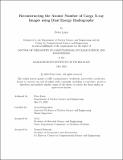Reconstructing the Atomic Number of Cargo X-ray Images using Dual Energy Radiography
Author(s)
Lalor, Peter
DownloadThesis PDF (16.44Mb)
Advisor
Danagoulian, Areg
Terms of use
Metadata
Show full item recordAbstract
To combat the risk of nuclear smuggling, the U.S. deploys scanning systems at ports of entry. Radiation portal monitors are capable of identifying unshielded nuclear or radiological threats by detecting radiation that is passively being emitted from a container. Radiography systems offer complementary detection capabilities, capable of identifying large, dense objects, such as a heavily shielded nuclear warhead. However, this analysis reveals that a smuggler might be able to evade detection from both passive scanning systems and radiography using a lightly shielded nuclear threat. One avenue to improve the capability to identify concealed illicit materials is through dual energy radiographic systems, which enable a rough elemental analysis of cargo contents due to the atomic number dependence of photon attenuation. This work investigates the capabilities and limitations for atomic number discrimination using dual energy MeV systems, finding that different materials can sometimes produce identical photon transparency measurements. This degeneracy introduces a fundamental ambiguity when differentiating between materials of different atomic numbers, even in systems with perfect resolution and no statistical noise. Despite these limitations, we describe a new and more precise method for approximating the atomic number of radiographic images by introducing a semiempirical transparency model. By incorporating a simple calibration step, this model captures second-order effects such as bulk scattering and uncertainties in the source energy spectrum and the detector response function. This methodology was benchmarked using both Monte Carlo simulations and experimental measurements from commercial scanning systems, demonstrating the ability to obtain accurate material predictions on noisy input images by incorporating an image segmentation step. Furthermore, we show that this approach can be adapted to identify shielded objects using a two-pass procedure.
Date issued
2024-05Department
Massachusetts Institute of Technology. Department of Nuclear Science and Engineering; Massachusetts Institute of Technology. Center for Computational Science and EngineeringPublisher
Massachusetts Institute of Technology